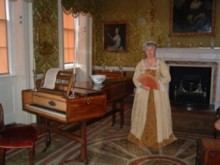No.1 Royal Crescent, Bath, is not just one of the city’s grandest addresses, but also provides a fascinating glimpse into the lifestyles of the wealthy and their servants during Bath’s elegant heyday.
The Royal Crescent, with its stretching, curved facade and 114 Ionic columns, is one of Bath’s most striking landmarks. Curving along the hillside above sloping green parkland, the street was built between 1767 and 1774 by John Wood the Younger. One of the finest examples of its kind, the Royal Crescent’s carefully symmetrical appearance unifies thirty grand town houses. Bath society consisted of long term residents, but also of visitors who would come for a ‘season’, to take the waters at the Baths, or simply to enjoy the social life. Some visitors would remain several years, others might retire here permanently. The Royal Crescent, then as now, was one of the most prestigious addresses for both long and short-term residents.
The house was presented to Bath Preservation Trust in 1968 and was carefully restored using period materials and techniques, before being opened to the public.
The building features original plasterwork, mouldings, and flagstones. Carefully-selected furnishings evoke the ambience of an elegant 18th century home. Visitors can admire the card-table in the study for the gentlemen, the smart drawing room, used for entertaining guests, a bedroom with concealed servants’ entrance, with helpful guides on hand in every room to explain furnishings and customs. Many modern visitors find the basement kitchen the most interesting of the rooms at No.1. From a practical viewpoint this would have been the hub of the household. Exhibited equipment and implements illustrate the techniques used by 18th-century domestic staff to keep the house warm and well-supplied, and its occupants fed and satisfied.
No.1 Royal Crescent is situated at the right-hand end of the street, as viewed from below. The building is open to the public from Tuesday – Sunday 10:30-5:30 and on Monday afternoons 12-5:30, with reduced opening in the winter; check the Bath Preservation Trust website for details. Note that last admission is one hour before closing. Combined tickets are available for No. 1 and the Building of Bath Collection.

